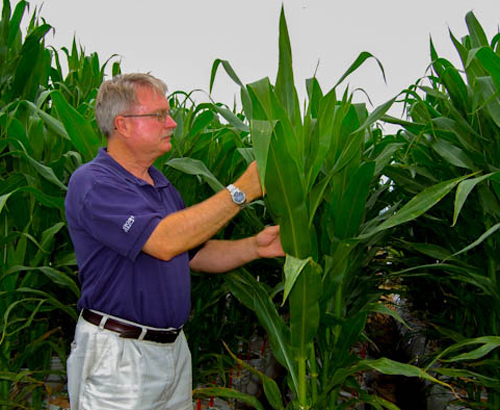By Andrea Seccafien, SPARK writer (Students Promoting Awareness of Research Knowledge)

Drive through rural Ontario this week, and you can’t help but notice the flurry of activity as farmers plant their 2013 crops. As new seeds germinate in the coming days, so too will the weeds, and that’s the kind of competition that can reduce yield potential and profits.
Plant agriculture professor Clarence Swanton leads a research project looking at weed stress in Ontario’s two largest field crops: corn and soybeans. He says the effort it takes for these crops to combat weeds can leave the plants weak, discoloured and more vulnerable to other environmental stressors.
He’s working with Profs. Lewis Lukens and Elizabeth Lee, also in the Department of Plant Agriculture, to understand how corn and soybean plants change their physiology when weeds are nearby.
Research leading up to this project showed the plants can detect weeds growing around them without physical contact; they use what’s known as light signalling. When a weed invades a plant’s growing space and sunlight, the plant reacts by changing the growth rate and structure of its root system. Energy that would normally be used for root growth is instead diverted to the plant’s stem to push itself above the invading weeds.
As a result, the plant is weakened because the underground support from the root system – something that’s vital for stress tolerance – is no longer enough to help the plant withstand environmental or pest-related problems.
To avoid this, producers should do early weed control, says Swanton. Applying pre-emergent herbicides at the seedling stage rather than when the weeds have already taken hold allows plants to grow stronger. “Some farmers wait to spray weeds, but our data suggest that they’re changing the yield potential by the minute the longer they wait to spray,” he says.
A plant’s growth trajectory changes every time it’s exposed to stress, he says.
“Exposing crops to stress is a slippery slope, with every stress shifting a plant closer to its breaking point. A single stress doesn’t affect yield potential on its own, but a buildup of stresses makes the plant more vulnerable to damage or collapse.”
Funding for this project was provided by the partnership between U of G and the Ontario Ministry of Agriculture and Food. Additional funding was provided by the Natural Sciences and Engineering Research Council and Grain Farmers of Ontario.